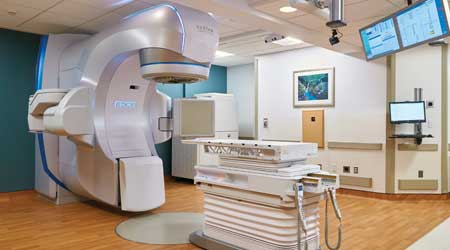 For the replacement of a linear accelerator at the University of Maryland Medical Center, the first step in the design assist process was a kick-off meeting on the job site with all stakeholders involved — crucial to getting all parties on the same page.RMF Engineering and Lenny Casper Photography
For the replacement of a linear accelerator at the University of Maryland Medical Center, the first step in the design assist process was a kick-off meeting on the job site with all stakeholders involved — crucial to getting all parties on the same page.RMF Engineering and Lenny Casper PhotographyCommunication, Responsiveness Are Keys for Successful Design Assist Projects
The design assist approach only works if everyone on the project team is constantly communicating and responding to questions and issues with urgency.
Communication is key to any project. Stakeholders must be in constant, ongoing communication regarding any key milestones – with good news and bad. Making critical engineering or construction decisions requires all stakeholders to have a seat at the table. To avoid any miscommunication or misinterpretations of what was communicated in the field, roles/responsibilities must be established during the first construction progress meeting for each discipline involved with the project.
Additionally, to ensure that a single path of information transmission is established between the team members (i.e., meeting minutes, site reports, etc.), it is important to assign one team member to run point and document and distribute all communications and correspondences.
The design/construction team recognized that everyone would need each other’s support to be successful. At weekly meetings, the team developed an understanding of other team members’ individual challenges for the week, such as the contractor’s equipment lead times or the engineer’s request for existing system parameters, etc. Each week, team members all listened to the other team members’ needs and collectively formulated a plan to resolve each challenge.
UMMC project manager Clayton Myers kept the team on track. The architectural/engineering-related construction issues could not all be resolved at the weekly meeting or on the job site. Some issues needed to be addressed outside of the meetings, such as the hospital’s administrative reviews and approval processes, and notifications for healthcare staff of the on-going construction issues and systems shut down, and others. But at each weekly progress meeting, Myers had the answers or processes in place for the project to continue moving forward and maintain schedule. This follow up was key to the success of the design assist approach.
Another key factor was responsiveness. Many times, throughout the project, the engineer would receive a phone call from the contractor asking questions on the piece of equipment being installed at that very moment. Most of the time, the questions could be answered over the phone. On some occasions, it was necessary to visit the site to resolve the issue. With the engineering firm located only 15 minutes from the UMMC campus, an engineer could be on-site to assist the contractor, and construction could continue without delay. Having the design team in close proximity to the job site proved to be a benefit to the project.
Working closely with the Varian representative early in the project and having a detailed understanding of the machine’s specific structural, mechanical, and electrical needs early in the process was another key factor in the success of the project. For example, it was crucial to know exactly what size utilities were needed and at what location before underfloor electrical conduits and cooling water pipes were buried in concrete.
“The design build and reverse engineering was the correct approach to this complex installation,” Myers said. “This enhanced the ability of the project team to deliver a 100 percent acceptable pre-installation checklist for Varian. This detail-oriented endeavor was paramount to the successful installation of the Varian Edge and quickly brought the linear accelerator on-line for patient use.”
Unlike the traditional design/bid/build approach, the time typically assigned to work through and refine the architectural and engineering designs (i.e., 35 percent, 65 percent, 95 percent) is removed from the process and replaced with on-site/hands-on coordination with the owner and contractors. Success can be achieved when the stakeholders buy in to the process, keep communication lines open, understand the obstacles each team member is facing, and develop a plan to work toward a common goal.
Paul Orzewicz, PE, is a mechanical engineer and division manager at RMF Engineering, with more than 30 years of experience managing projects of all sizes and complexity.
Related Topics:











